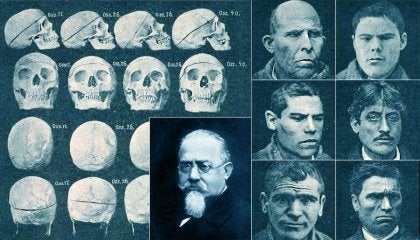The name Cesare Lombroso is strongly linked to the history of criminology, his classification of criminals has long been the main tool for establishing criminal profiles, in fact, many of his assumptions are still being debated in the legislation.
Cesare Lombroso, a physician and training anthropologist, is considered the father of criminology. Is your work the first systematic compilation in this field. Along with Enrico Ferri and Raffaele Garofalo, Lombroso was one of the great representatives of positivist criminology.
- “There are certain clues at the crime scene that.
- By their very nature.
- Cannot be collected or examined.
- How do you collect love.
- Anger.
- Hatred.
- Fear?Are these things we’re trained to know how to look?-James Reese -.
Cesare Lombroso’s thinking was strongly influenced by Darwin’s theories. In this sense, Lombroso went so far as to say that criminals were “the missing link”, a being who was at an intermediate point between the monkey and man.
The culmination of Cesare Lombroso’s work was his classification as criminals, dividing them into: natural criminal, crazy moral criminal, epileptic criminal, mad criminal, passionate criminal and casual criminal. Let’s see how you defined each of these categories.
For Cesare Lombroso it was possible to determine if someone was a criminal by analyzing her bodily characteristics. According to his approach, the offender has traits of organic and psychic inferiority that are visibly obvious.
In the case of the born criminal, this is characterized, from a physical point of view, by the following characteristics: small skull, large eye socket, inclined forehead, bulge in the lower part of the head, from a psychological point of view, is insensitive, impulsive and does not feel remorse.
According to Cesare Lombroso, the mad moral criminal is rarely admitted to special psychological care facilities; instead, it is often found in prisons and brothels; he is cunning, unfriendly, vain and selfish.
From a physical point of view, he looks like the born criminal, with a prominent jaw, his face has several asymmetry. However, in this case, it is not easy to identify it by its appearance, but by its behavior, they pretend to be crazy and from a young time we can identify this way of being in them.
For Lombroso, epilepsy was a sign of crime. This crime could manifest itself as usual, with seizures, or without any apparent manifestation, in both cases we would be talking about one of the most dangerous criminals.
They are characterized by being animal lovers, destructive and vain. Lombroso also claims that they tend to commit suicide and that, with moral fools, they are the only ones looking to associate to commit crimes.
Cesare Lombroso distinguishes between mad criminals and mad criminals; mad criminals are said to be sick people who do not reason and are not responsible for their actions; crazy criminals, on the other hand, commit a crime and go crazy in jail.
He points out that there are three types of mad criminals: the alcoholic, the hysterical and the mattoid, the first is the one who gets drunk and commits crimes, the hysterical has a great tendency to lie and a natural inclination for eroticism. on the other hand, it’s on the line that separates reason from madness and commits impulse crimes.
The passionate criminal acts by impulse and is motivated by noble passions, has no particular physical characteristics that identify him, except for his age, 20 to 30 years old.
This type of offender is extremely affectionate and has a lot of fuss after committing the crime, sometimes trying to kill himself. The reasons for committing a crime can be three: bereavement, infanticide, and political passion.
Lombroso says that casual criminals are divided into three groups: pseudo-criminals, criminals and professional criminals; the former commit crimes that can be of three types: involuntary, without perversity (motivated almost always out of necessity) and in self-defense.
Criminaloids are those who commit motivated crimes or under pressure from circumstances, under normal conditions they would not commit the crime, although they have some predisposition, finally, professional criminals are those who combine legal activities and crimes.
The theory and classification of Cesare Lombroso’s criminals remained in force for some time, but was later radically reassessed, observing serious flaws in the various contrasts with the scientific method.
Moreover, sometimes his theory became dangerous: he incited prejudice and sometimes proposed “final elimination”?Criminal.

